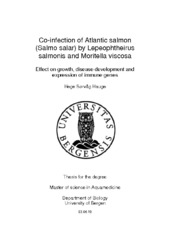| dc.description.abstract | A co-infection is defined as an infection with two or more different pathogens, where the pathogens can either have a synergistic or antagonistic effect or alternatively not affect each other at all. Lepeophtheirus salmonis are the single largest problem found in salmonid farming today. It is a marine ectoparasitic copepod (Caligidae) occurring on both wild and farmed salmonids in cold temperate waters in the North Atlantic and North Pacific Ocean. They feed on mucus, skin and blood of their host leading to mild skin lesions that can disturb the osmotic balance. Moritella viscosa is a gram-negative bacterium thought to be the main agent causing winter ulcer disease in salmonids and occurs when water temperature is under 10 ºC. Clinical signs are necrosis of the skin, which advance to skin lesions on the flank, ranging from raised scales to larger lesions with exposed muscle tissue. This study looks at the co-infection of L. salmonis and M. viscosa and how these two pathogens affect growth, disease development (lice and ulcer number, size and severity) and transcription of immune genes. Study fish were sampled at four time points: (A) 5 days prior to infection, (B) 6 days post infection (dpi) L. salmonis; 7 dpi L. salmonis and 2 dpi M. viscosa [co-infection] dpi. (C) 26 dpi L. salmonis, 23 dpi M. viscosa [co-infection]. (D) 40 dpi L. salmonis, 37pi M. viscosa [co-infection]. During sampling, weight, length, condition factor (K-factor) was measured; lesions were counted, sized and graded; Lice were counted and staged. Transcription of immune genes Interleukin 1b (IL-1b), Interleukin 4 (IL-4), Interleukin 8 (IL-8), Interleukin 10 (IL-10), complement protein 3 (C3) and Immunoglobulin M (IgM). 2-ΔΔCt were analyzed from sampling B and C in skin and head kidney with Elongation factor α (EFα) as a reference gene. Results showed that a M. viscosa infection (both single and co-infected) did affect weight and k-factor compared to control and L. salmonis., but no differences between a M. viscosa single and co-infection. M. viscosa were to be able to develop or infect faster under a single infection but over time there were more ulcers on co-infected fish. Also, a larger area of the fish was covered in ulcers for co-infected fish. No difference was observed in grade/severity of lesions. Similarly, there were more L. salmonis in a single infection compared to co-infection. The co-infection did not affect developmental rate of L. salmonis. There was a higher expression of pro-inflammatory genes (IL-1β and IL-8) for co-infected fish at time B. And a lower expression of anti-inflammatory genes (IL-4/13A and IL-10). IL-4/13A had a lower expression in almost all skin sites, and co-infected head kidney. IL-10 B was significantly lower for all co-infected sites at time B. There were no clear differences in expression of C3 and IgM for co-infected fish. | en_US |
